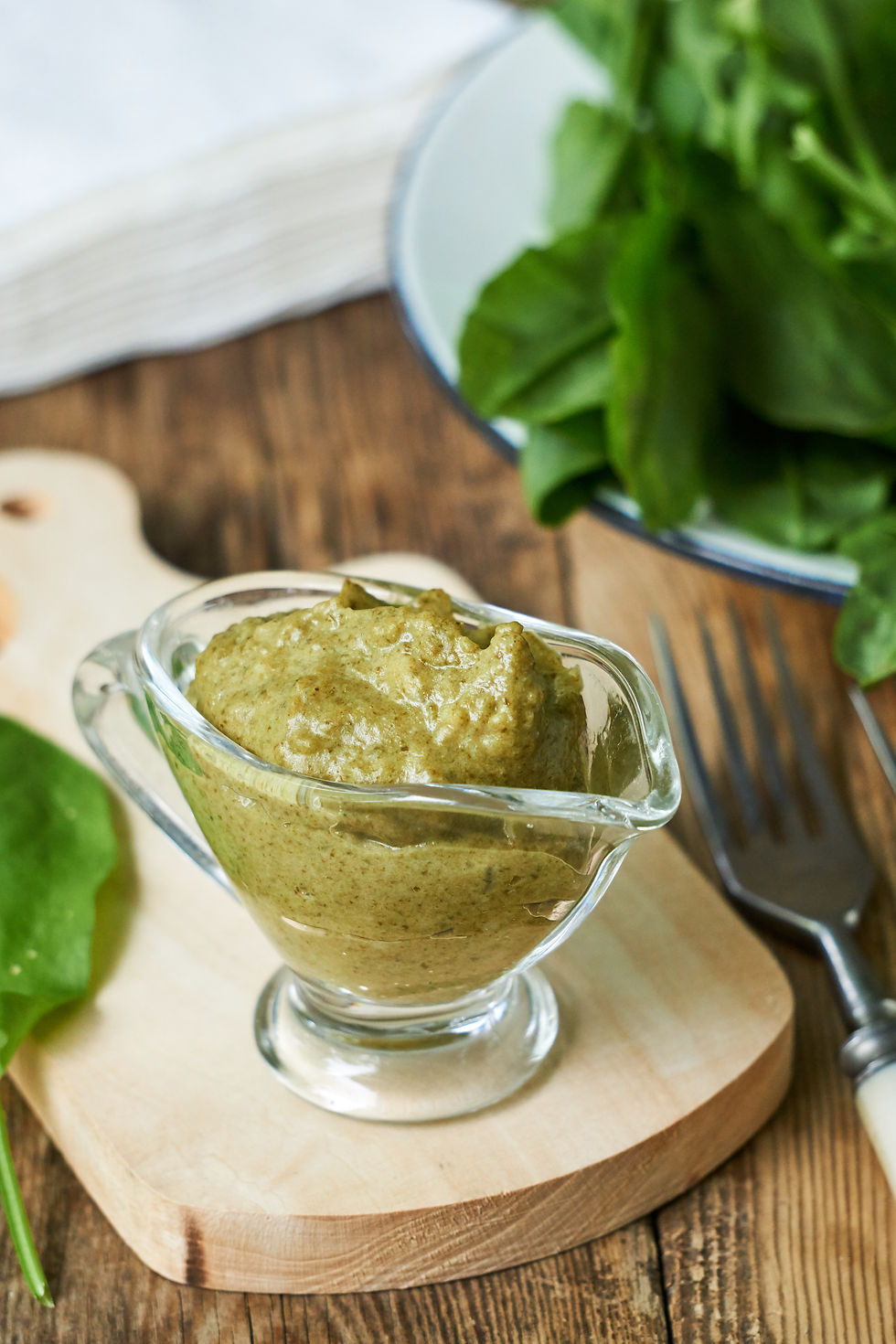Sorrel: A Flavorful Herb with a Tangy Twist
- Cynthia
- Aug 18, 2024
- 4 min read
I'd only vaguely been aware of Sorrel until recently when a favorite vendor at the local farmer's market started selling it. He gifted me a lovely bunch and I was determined to learn all I could about how to use this intriguing herb.

What is Sorrel? Sorrel is a leafy green herb that belongs to the buckwheat family. It's known for its bright, lemony flavor, which comes from the oxalic acid it contains. The arrow-shaped leaves are usually green, although some varieties have a reddish or purplish hue. Sorrel has been used in cooking and traditional medicine for centuries, particularly in Europe and the Middle East.
Health Benefits: Sorrel is rich in vitamins A and C, iron, and magnesium. It’s also a good source of fiber and antioxidants. The oxalic acid in sorrel gives it its distinctive tangy taste, but it can be hard on the kidneys in large quantities, so it's best enjoyed in moderation.
Culinary Uses: Sorrel's tartness makes it a versatile ingredient in the kitchen. It can be used both raw and cooked, depending on the dish. Listed below are some popular ways to use sorrel.
Salads: Fresh sorrel leaves can be chopped and added to salads. Their sharp, tangy flavor pairs well with milder greens like spinach or lettuce. They also complement creamy dressings or vinaigrettes.

Soups: Sorrel is famous for its use in soups, especially in French and Eastern European cuisine. Sorrel soup, also known as "green borscht," is made by simmering sorrel leaves (see the recipe at the end of this post) with potatoes, broth, and sometimes a boiled egg for a hearty, flavorful dish.

Sauces: Sorrel can be blended into a sauce to serve with fish, poultry, or vegetables. A classic French sauce is made by cooking sorrel leaves with butter, cream, and sometimes a little white wine or broth until it forms a smooth, tangy sauce.

Pies and Tarts: Sorrel's acidity can cut through rich fillings in savory pies and tarts. It pairs well with ingredients like cheese, eggs, and root vegetables.

Smoothies: For a refreshing, nutrient-packed smoothie, add a handful of sorrel leaves to your blend of fruits and vegetables. The tartness of sorrel works particularly well with sweet fruits like apples or pears.

Pesto: Sorrel can be used in place of basil in pesto for a unique twist. Blend sorrel leaves with nuts, garlic, Parmesan cheese, and olive oil for a tangy spread that works well on pasta, sandwiches, or as a dip.

Sorrel Cooking Tips:
Balance the Flavors: Sorrel's strong taste can dominate a dish, so it’s often balanced with creamy, starchy, or sweet ingredients.
Add at the End: When cooking sorrel, add it toward the end of the cooking process, as it wilts quickly and can turn brown if overcooked.
Use Fresh: While dried sorrel is available, fresh leaves offer the best flavor and texture.
Sorrel is a delightful herb to explore in the kitchen, offering a bright and tangy flavor that can elevate a wide range of dishes. Whether you're making a classic sorrel soup or experimenting with a sorrel pesto, this herb is sure to add a refreshing twist to your meals.
To this end, I hope you'll try this classic French soup that is perfect for hot summer days!
The challenge for Sorrel newbies, is that when cooked, Sorrel tends to turn a greenish-brown. It tastes fine but that color can dampen one's enthusiasm. The good news is that I found, after long searching, the 'fix'! Add it to the hot soup as a ‘paste’ similar to pesto! Then, the Sorrel retains its bright green color and flavor … even after multiple, serious reheatings.

Soup Base
1 small onion or leek (just the white part), chopped (1/2 cup total)
1 Tbs. butter or olive oil
1 small clove garlic, minced
1 medium baking potato, peeled, or ½ lb. (8 ounces) Yukon gold potatoes, peeled (if you like, but I don't bother) and diced
3 cups water or broth
Sorrel Paste
4 cups sorrel leaves (3 oz./90 g.), stems trimmed
2 Tbs. (1 oz./30 g.) softened butter or olive oil (I prefer olive oil)
SAUTE the onion or leek in butter or olive oil in a medium saucepan 3 to 4 minutes, or until softened. Stir in the garlic, then add the potato and water. Season with salt and pepper. Cover, and simmer 20 to 25 minutes, or until the potato pieces are very soft.
MEANWHILE, MAKE the Sorrel Paste. Pulse the sorrel leaves in a food processor until finely chopped. Add the butter or olive oil, and process until a smooth paste forms.
PUREE the soup with an immersion blender until very smooth, then stir in the sorrel paste. Adjust seasonings, and serve hot or cold. Alternately, add the soup directly to the sorrel paste in a food processor, and blend everything until smooth. Adjust seasonings, and reheat, if necessary.

Comments